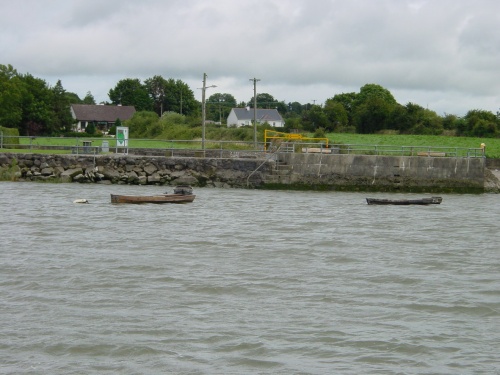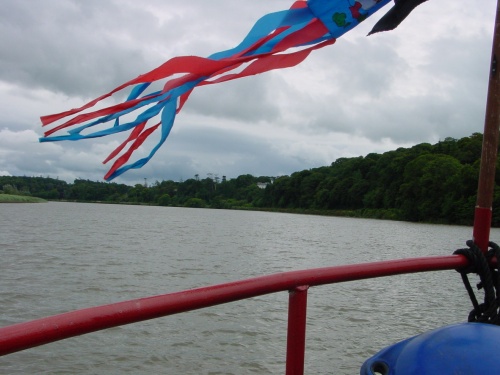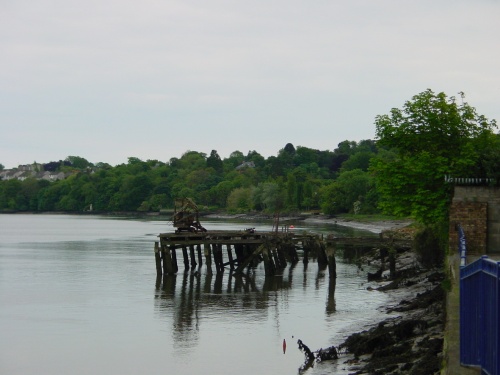This is an account of a trip down the River Suir from Carrick-on-Suir to Waterford, aboard the ex-Grand Canal bye-trader 31B Williams and Woods. Many thanks to Mick Farrell for the trip. This navigation is not entirely abandoned, as pleasure boats still use it, but in bygone days it had much commercial traffic, as well as a busy sand trade. The sand trade is long gone and the last commercial traffic, the oil tankers supplying Morris Oil at Fiddown, will cease when Waterford’s new road bypass bridge is built.
Update 6 January 2011
If George Stephenson, Father of Railways, had had his way, you might have been able to travel down the Suir in a railway carriage. Read about his proposal here.
Update 6 August 2009
Added four more photos of the new Waterford road bridge.
Update 8 June 2009
Added some photos of the Rocksand, the new Waterford road bridge and the old railway bridge.
31B
The Suir Navigation
River transport between Waterford and Carrick (sand, coal, corn, timber) had been based on unpowered lighters that used the tide to ascend and descend the Suir: it is tidal to just above Carrick. At one stage there were hundreds of men in the trade; according to William O’Callaghan, his family’s lighters were pitch pine, 71′ X 16′. Lighters were built in Carrickbeg, which is on the south side of the Suir opposite Carrick-on-Suir: three firms of boat-builders are listed in Slater’s Directory of Ireland of 1870 and one of them, Keogh Brothers, were still active in 1919 according to Kenny’s Irish manufacturers’ directory of that year.
The lighter’s crew of two used 30′ steel-shod poles for manoeuvring at close quarters; for steerage, to keep in the tidal stream, they each had a 35′ or 36′ sweep, each stroke of which meant walking six steps forward and six back. The oars swivelled on 2″ oak dowels. Waterford County Council’s library service has a good photo of a lighter in Waterford online here; if that doesn’t work, go here, select the Lawrence Collection from the main part of the page and then enter 0001416 in the search box at the top left.
There was a separate, horse-drawn, trade from Carrick-on-Suir upstream to Clonmel; it is covered on a separate page.
The Suir Steam Navigation Company
In 1877 Messrs John Grubb & Son (MD J Ernest Grubb) put the tug Father Mathew on the Waterford to Carrick-on-Suir run. It could tow four lighters to a maximum of 160 tons and could carry passengers to fairs in Waterford. Grubb was a Quaker; he named his tug after the temperance crusader as he too opposed misuse of alcohol.
Grubb’s tug threatened the lighter trade and his business eventually controlled much of the river trade. He retired in 1912 and his Suir Steam Navigation Company was bought by Thomas Walsh & Son in June of that year. They continued the trade to Clonmel until 1920 or 1921; in 1927 they sold the Father Mathew to the Tarpey family of Carrickbeg but sold the Waterford–Carrick business to Edward J Dowley & Sons (who had bought the Grubb stores at New Street in Carrick).
The Dowleys fleet
It is possible that Dowleys did not take the opportunity to buy the Father Mathew in 1927 because, in 1912, they had bought a tug of their own, the Knocknagow, for £1,600. Dowleys eventually owned four boats altogether:
- the Knocknagow of 1912, which could carry about 40 tons. Dr Patrick C Power says that its first skipper was J Healy and that the cost “was recouped quickly by towing sand-boats that collected river-sand for Waterford builders”. William O’Callaghan said that the Little Knocknagow was regarded more as a tug than as a cargo-carrier: being very deep aft, the propellor was never out of the water, even when empty, so the boat was good at towing, and would often give a tow to unpowered sand and gravel boats. When the Big Knock was added to the fleet, this boat became Knocknagow II or The Little Knock or The Little Tug. After many years on the Slaney, it is now on the Shannon
Knocknagow in Carrick-on-Suir (photo courtesy Brendan Cleary)
- the New Forge, which carried a little over 60 tonnes and was described as more like a canal boat, being blunt in front. It had a two-man crew and a Gardner engine that was notoriously hard to start: handles at the two ends of the engine had to be swung in opposite ways. The New Forge is currently based in on Lough Erne, having been based in Shannon Harbour for many years
The Newforge, adapted since it worked in the Dowleys fleet
- the Rocksand, which may have been called Corsand at some stage (there was a servicing vessel called Corsand based at Ipswich, in the Nore Command, in World War II). It had a single-cylinder Plenty-Still engine and a three-man crew. It carried 200 tonnes (usually grain downriver, fertiliser up) and was the least-used of the Dowleys fleet and the first to be sold off. It berthed at their downstream yard, along with the lighters and concrete barges, and was used for storage when not required for transport. After being sold off, the Rocksand was used in the dismantling of the old New Ross bridge in 1968 and then became the floating pontoon base, with kitchens and offices, for the New Ross Galley cruising restaurants
The Rocksand (photo courtesy Brendan Cleary)
The Rocksand in its current role in New Ross
The Rocksand with the St Ciaran alongside
- the Knocknagow I, also known as the Big Knock and the Big Tug. The Knocknagow I seems to have been the last boat to carry goods on the Suir, in 1973, but sand-dredging continued until 1983, when William O’Callaghan’s sand barge ceased operations. The Knocknagow I was in the sand trade for some time, but it is now said to be sunk up the Nore. I have no photos of it.
The two Knocknagows (and the New Forge?) travelled the Suir almost every day, missing out only when held up, eg if shipping had not come in. Leaving Carrick at 07.00, if the tide was right they would be moored in Waterford by 09.30 or 10.00. That meant the crews started work at 06.00; if they were back in Carrick before 19.00, they got no overtime.
Dowleys sold out to Suttons in 1982; Suttons was subsequently acquired by IAWS, although it sold the Carrick operation (and two others) to its Cork Managing Director, who set up Goldcrop. I have spoken to people in IAWS, two of whom were involved in the acquisition of Dowleys/Suttons, but they think there are no remaining records.
The moorings in Carrick-on-Suir
The new Public Marina in Carrick-on-Suir “is operated by Carrick-on-Suir Boat Club by agreement with Carrick-on-Suir Town Council.” It is located on the stretch between the two bridges in Carrick in the area known as The Pool. It is beside where the Dowleys stores were, on the North Quay; Dowleys had two loading gantries overhanging the river, and Knocknagow’s berth was at the foot of Oven Lane. The quays were concreted during World War II. High water-levels often flooded the premises, and the office (as well as the boats) had to get copies of the Waterford tide tables each January. Every night barrow-loads of yellow clay would be used to block the doors and there was an automatic underground pump to drain from the yard to the river.
The marina, with two cots in the foreground
There are now two blocks of flats there; one of them is called Knocknagow.
Knocknagow flats
There are some reminders of the old days.
Warehouse
Dowleys had a second premises downstream, off the main course of the river, at Ballylynch. The Rocksand and the lighters were usually kept there.
The loo on the quay at Ballylynch
The quay at Ballylynch with two bollards (looking downstream)
Close-up of a bollard
A crane with a bucket, sometimes using slings, emptied phosphates and potash from the boats and conveyed them to the store where Dowleys blended their fertilisers (4.4.8 and 0.5.10), for sale in 2cwt jute bags, well into the 1960s. Although it was a small plant, it despatched 50 to 60 tons per day, selling both wholesale and retail. There was a grid here, based on an outflow pipe with short arms (skips?) at right angles to it, on which a vessel could take the ground at high tide; the bottom could then be inspected when the tide went out, and plates could be welded on if necessary.
Looking upstream. I think the grid was somewhere in that area
But back to the marina, for the voyage downriver.
Cruiser Vicki May at the marina
68M leaving Carrick, with Carrickbeg in the background
Barge Dabu (originally horse-drawn) leaving Carrick
31B preparing to leave
Ormond Castle on the left below the town
The short navigation cut
Islands to the north of the boatstream
Approaching Roches Quay on the right
Passing Roches Quay
Spectators below Roches Quay
This may be the Lingaun River
Abandoned boat below Tybroughney Castle
Cruiser Rindoon at Tybroughney Castle
The cruiser ahead is about to take a sharp left to head east
Breach in the embankment at the bend. One of the concrete barges, formerly towed by the Knocknagow, is said to have been used to shore up a breach
This may be the mouth of the Pil
The upstream end of Fiddown Island. The R/H channel is not navigable
Amenity area above Fiddown Bridge
Fiddown Bridge, where the Engineer of the Little Knocnagow was killed
Morris Oil depot, supplied by tanker
Through Fiddown Bridge
Morris Oil maintained the buoys between Waterford and Fiddown. However, tankers won’t be able to reach them when the new Waterford road bypass bridge is built and Morris will have to move, so the buoyage will have to be looked after by somebody else.
Morris Oil
Navigation mark on the downstream end of Fiddown Island
Looking back up the non-navigable channel towards Fiddown Bridge
Morris buoy below Fiddown
Wide open spaces
Rocketts Castle and Russian House
Rocketts Castle and Russian House
The mouth of the Clodiagh
Pollrone Quay
Bending eastward again
Windyhouse boat slip for snap-netters (I think)
Mount Congreve, renowned for its gardens, just about visible
Quay above Granny (Granagh). A wind blowing along this reach could make conditions quite unpleasant
Granny Castle
Just past the castle there is a slipway belonging to Granny Boat Club (which also seems to have pontoons in Waterford).
The slipway at Granny Boat Club
Boats coming ashore at Granny
At the top left of the photo, you’ll see the river bending south (you’ll also see the mud banks along the river).
Here is a more recent photo, taken from outside the Boat Club but looking in more or less the same direction.
The new Waterford bridge
Here are four more photos of the new bridge, taken from Granny in August 2009. I think they give a good idea of the size of the thing.
Waterford bypass bridge (August 2009) 1
Waterford bypass bridge (August 2009) 2
Waterford bypass bridge (August 2009) 3
Waterford bypass bridge (August 2009) 4
Just beyond the bend is the old railway bridge, known locally as the red iron bridge (thanks to Brendan for this information).
The old railway bridge
Passing through the old railway bridge
The eastern end of the railway bridge
The control cabin
Pontoons like this were used in Waterford because it’s so muddy along the quays
Commuter train on the Dublin line
The nearer vessel is the only Guinness Liffey barge still afloat
Rice Bridge (which has an opening span) is currently the only road bridge in or near Waterford. The bypass will thus double the number of bridges
Fastnet Shipping: if you want a tug or a dredger or …
Approaching Rice Bridge
The former Cherrys Brewery, which now makes the secret ingredient for cans of Guinness (or something)
The (opening) navigation span
The current: not too bad
Waterford City Marina, developed and run by the City Council. Expensive, though, especially for a 60-footer ….
Wallace Plaza, named after the composer William Vincent Wallace
On this trip, our attention was focused on the right-hand side of the river, but here’s a photo of the other side (taken form the quay). All due for development (assuming builders ever again get a few quid): the port has moved downstream to Belview.
The left side of the river
And moving a little further downstream, this (taken from the land) might be the remains of the quay for Graves & Co, the firm that owned the first Bolinder-powered boat in Ireland.
Graves quay?
Back upriver, here is Reginalds Tower.
Reginalds Tower
Dabu has turned to head upstream …
… as the fleet is heading for St John’s Pill (or River) …
… which is usually home to smaller boats …
… but where the heavy metal can take the ground – without paying City marina prices.















































































A very nice collection of photos you have :-)
Thanks, John. I’ve just added some photos of the Rocksand, the new Waterford road bridge and the old railway bridge.
Nice photos, very interesting page, just to let you know that the old railway bridge was always known locally as ‘the red iron bridge’ as up to the time when it went out of use, it was always (painted?) a redish colour
Thanks, Brendan. I’ll put in a note to that effect.
bjg
great photos ,always wanted to go that far down but i only have a canoe ,think it might be a bit rough for me .so thanks for the view of your journey .
Thanks, Joe. I’ve just added a page about the upper Suir, from Clonmel to Carrick, including some comments that might interest you from canoeists of bygone days. See .
bjg
good stuff. strange to see places so well known from such unusual angles and vantage points !
I could be wrong, but I think that shot of the train leaving Waterford station would be of the Limerick service, and not the Dublin line – the two lines run parallel out of Waterford, as far as Newrath.
Lovely work though – well done to you !
Well done on all this very interesting information & photos.
Is it possible to hire/rent a small boat which could make the journey from Clonmel to Waterford, passing Carrick at high tide ? Regards & thanks. JBD
Thanks, John. I’m afraid I don’t know anyone hiring out boats on the Suir and I’m based a bit far away. I’d suggest contacting the folks on http://www.riversuir.ie/ or some of the angling clubs http://www.srfb.ie/fishing/salmon_trout/suir.html or Jim Power in the Carrick-on-Suir Boat Club via http://www.carrickonsuir.ie/river/186
bjg
I’m very interested in Waterford.
What site are about the Waterford Area, URL’s.
I would like to know as much as I can about the area!
TIA,
Burr
Lovely trip down memory lane – much travelled by myself coming back from Limerick for the past 30 years – sad that the coal boats wont get up to Fiddown any more
Thanks, Michael. I’ve travelled that road a good bit myself (though not for as many years as you). You may be interested in my page about the Suir between Carrick and Clonmel; I hope to add some more pics to that soon.
bjg
Many thanks for this mate. Lovely reading to end my work day. Great photos….I may be oblated to bring along my trusty Speed Graphic camera this spring & leave the digital at home in Nfld.!
Cheers,
Richard
Hi Michael,
I grew up in Carrick and spent many hours playing as a kid on The Knocknagow in the 1960’s when it was berthed either in Ballylynch or where the New Public Marina is situated. I will email you a photograph taken near Carrick of The Knocknagow towing a Lighter upstream.
Your excellent wenbsite is full of nostalia for me. Even today I have a barge berthed outside by front window !
Kind regards
Peter Power-Hynes
Chelsea Harbour
Thank you very much, Peter. I’ll contact you direct as well. bjg
Pingback: Canal carrying 1846: Dublin to Waterford | Irish waterways history
Hi Brian,
The erection of the new bridge in Waterford did not interfere with shipping to Fiddown, or to the EMO Oil Depot (as far as I know). Such shipping had already ceased due to the unavailability of oil tankers small enough to navigate the upper part of the Suir. Presumably if someone built an oil tanker small enough to get to Fiddown it could still get upriver. I don’t think the new bridge blocked river access?
Do you know of any charts available for the area above Waterford? as Admiralty cease at waterford bridge.
No official charts, but the Carrick-on-Suir boat club, at the marina, produced a guide few years ago. I think you’d have to make local contacts to get a copy. Some of the Waterford clubs might be able to tell you where to get a copy. bjg
Pingback: Ormond Castle, Carrick-on-Suir - BikerOnTheBack